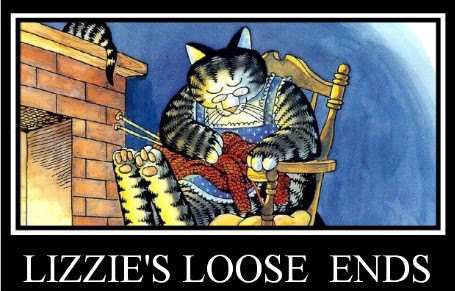- Manly Socks
-
I quit working on the first sock because I don't know exactly how long to make it. So that's what I've accomplished on the second sock.

This was dyed with Brown Wilton's Food Coloring Paste. (It's a bit more red than shown here...probably fall into the "cinnamon" category.) One of the problems with using Wilton's is that combination colors (anything besides the primary colors of red, blue and yellow) will often split when one is dyeing. Parts of the color combinations will strike the wool first giving it an uneven variegated effect. Which is very pretty. But it may not be what you want. I'd read awhile back that if you put the paste in the dye bath, add the yarn and then add the acid, it will minimize the splitting. So, I tried it. And it worked. Amy, here's what I did:
Soaked yarn in hot water. Put pot of water on to boil. In the mean time, I put the Wilton's paste in a half full jar of hot water and shook it a lot. Wilton's doesn't dilute easily in water. When the water was steaming, I turned down the heat, added the Wilton's mixture and stirred.
Added the yarn and poked it all down so it was submerged. Then added about half a cup of white vinegar and let it steep. The yarn turned brown but there was still some olive green in the water. So I added about another half cup of white vinegar. That caused the green to strike and the water to be clear. I let it steep a while longer, then removed the yarn and hung to dry.
It didn't dye perfectly even (but I prefer some variation to give depth to the knitted item), but it did strike far more even than anything I've ever dyed with Wilton's before.
Kimba: No, food colorings (acid dyes) don't work on cotton.
 It's not color fast at all. I've tried it several different ways..... It only works on protein (those from animals) fibers: wool, hair, silk, and for some weird reason, nylon. And yes, it will dye your hair.... Cellulose fibers (from plants) need other mordants, as you well know.
It's not color fast at all. I've tried it several different ways..... It only works on protein (those from animals) fibers: wool, hair, silk, and for some weird reason, nylon. And yes, it will dye your hair.... Cellulose fibers (from plants) need other mordants, as you well know.
Grandma Nana: Dyeing yarn is very easy!
 You need 100% wool or a wool blend. Superwash is the easiest to work with--don't have to worry about felting the yarn. My suggestion is to get a couple packages of Kool Aid. Fill a pot with water, heat to steaming. In the mean time soak the yarn in hot water...usually about half an hour. Put Kool Aid in the water and stir. Add the yarn and stir gently. Within a few moments, the water will be clear and the yarn will be colored. Let sit awhile....dump the water into a colander. Take out the yarn, squeeze out the water and let dry. It's easiest if you have the yarn in a skein rather than a ball, but balls will dye. The outer yarn will be darker and it will get lighter towards the center. Depending on how tightly wound the ball is, it may even be the original color in the center. Check my Tag Cloud (to the left of this post) for KA and dyeing to get more information. Using a search engine will give hundreds of sites with info on doing it. Really, it's very easy and more fun than knitting! (Is that heresy???)
You need 100% wool or a wool blend. Superwash is the easiest to work with--don't have to worry about felting the yarn. My suggestion is to get a couple packages of Kool Aid. Fill a pot with water, heat to steaming. In the mean time soak the yarn in hot water...usually about half an hour. Put Kool Aid in the water and stir. Add the yarn and stir gently. Within a few moments, the water will be clear and the yarn will be colored. Let sit awhile....dump the water into a colander. Take out the yarn, squeeze out the water and let dry. It's easiest if you have the yarn in a skein rather than a ball, but balls will dye. The outer yarn will be darker and it will get lighter towards the center. Depending on how tightly wound the ball is, it may even be the original color in the center. Check my Tag Cloud (to the left of this post) for KA and dyeing to get more information. Using a search engine will give hundreds of sites with info on doing it. Really, it's very easy and more fun than knitting! (Is that heresy???)One can overdye commercially, Kool Aid, or food coloring dyed wool. If one had a yellow yarn and overdyed with blue, the result would be a green. Or a bright red overdyed with some green would tone down the red towards a brown. A working knowledge of color theory <--click is useful but not necessary if one doesn't mind experiments going awry!
Ewey! Get yourself busy! Like you have all the spare time in the world!

Didn't find too much of interest on the web today, but here's what I did see:
A good set of instructions for the click--> jogless jog (or how to avoid that hitch in color changes when knitting in the round). And a vintage click--> cable sock pattern.
Sunday, June 3, 2007
June 3, 2007
Subscribe to:
Post Comments (Atom)
.jpg)

No comments:
Post a Comment
I really am glad you're commenting. Please make sure I can find you by insuring you leave an e-mail address. It's so frustrating to have someone ask a question and no way to answer them! Thanks!